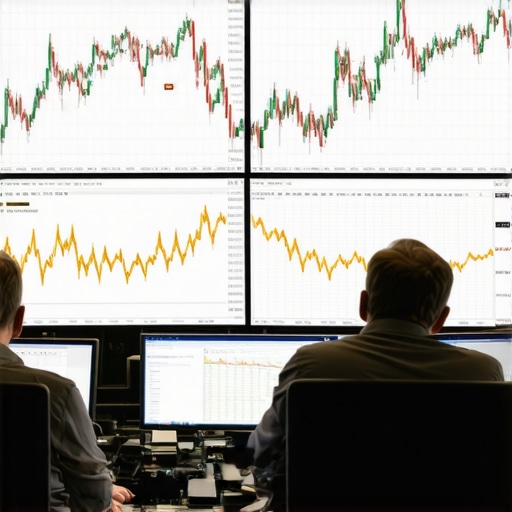Understanding Gold Trading Strategies: A Path to Portfolio Optimization
In today’s volatile financial environment, investors are increasingly turning to gold as a safe haven and a reliable asset to include in their portfolios. Gold trading strategies can empower investors to optimize their portfolios effectively. As we delve into these strategies, we will explore how to navigate the gold market, the various forms of gold investments available, and key considerations for making informed decisions.
Why Invest in Gold?
Gold has historically served as a hedge against inflation and currency fluctuations. Its intrinsic value and limited supply make it a preferred asset during economic downturns. By understanding the dynamics of the gold market, investors can develop robust trading strategies that align with their financial goals. For instance, analyzing current market trends can help investors identify optimal entry and exit points.
Types of Gold Investments: Navigating Your Options
Investors can choose from various forms of gold investments, including physical gold, gold ETFs, and gold mutual funds. Each option has its unique advantages and risks, which should be considered carefully. For those interested in physical gold, understanding the differences between gold coins and bullion bars is crucial for making informed purchases.
Gold ETFs provide a more liquid and less cumbersome way to invest in gold without the need for physical storage. Investors should evaluate their preferences and risk tolerance when choosing between these investment types. For more insights on gold ETFs and mutual funds, check out our guide on comparing gold ETFs and mutual funds.
Key Strategies for Trading Gold Effectively
Adopting effective gold trading strategies is essential for optimizing your portfolio. One popular approach is to leverage technical analysis, which involves studying price charts and market patterns. This technique can help traders make informed decisions about when to buy or sell gold. Additionally, understanding demand trends can provide valuable insights into potential price movements and market behavior.
Another vital aspect of gold trading strategies is diversification. By spreading investments across different asset classes, including gold, investors can mitigate risks and enhance their potential returns. As you consider your portfolio, remember to balance your gold investments with other assets to optimize overall performance. For detailed strategies on diversifying your investments, refer to our article on best practices for gold investment strategies in 2025.
Finally, staying updated on global economic news and geopolitical developments is crucial for any investor in the gold market. Economic indicators, such as inflation rates and interest rates, can significantly influence gold prices. By keeping informed, you can adjust your trading strategies to align with changing market conditions.
Maximizing Returns with Advanced Gold Trading Techniques
As you delve deeper into the world of gold trading, mastering advanced techniques becomes essential for optimizing your investment portfolio. These strategies not only enhance your understanding of market dynamics but also equip you with the tools necessary to navigate fluctuations effectively. One critical approach is to implement effective trading techniques that can amplify your returns while managing risks.
Understanding Market Sentiment and Its Impact on Gold Prices
Market sentiment plays a pivotal role in gold pricing. By analyzing investor sentiment, traders can anticipate price movements and adjust their trading strategies accordingly. Tools such as the Commitment of Traders (COT) report can provide insights into how traders are positioned in the market. Understanding when to react to bullish or bearish sentiments can lead to timely investment decisions, making it crucial to stay updated on current trends and predictions.
Utilizing Technical Indicators for Informed Trading Decisions
Technical indicators are powerful tools that help traders identify potential entry and exit points. Common indicators include moving averages, Relative Strength Index (RSI), and Bollinger Bands. By integrating these indicators into your trading strategy, you can enhance your ability to make data-driven decisions. For instance, using moving averages can help identify support and resistance levels, which are critical for planning trades. To learn more about the application of technical indicators in gold trading, check our article on essential gold trading techniques.
The Role of Fundamental Analysis in Gold Trading
While technical analysis focuses on price patterns, fundamental analysis examines the underlying factors that influence gold prices. This includes macroeconomic indicators such as inflation rates, interest rates, and geopolitical events. By understanding these factors, investors can better predict how external conditions will impact their gold investments. For a comprehensive overview of how these elements interact with the gold market, refer to our guide on key data every investor needs.
Implementing Risk Management Strategies
Risk management is a cornerstone of successful trading. In the volatile gold market, employing strategies such as setting stop-loss orders can protect your investments from significant downturns. Additionally, diversifying your portfolio by including various asset classes, such as stocks or bonds, alongside gold can help mitigate risks further. For more insight on managing your investment risks, explore our article on finding the right gold investment.
As you refine your gold trading strategies, remember that continuous learning and adaptation are vital. The gold market is influenced by numerous factors, and staying informed will empower you to make smarter investment choices. In our next section, we will dive into the importance of timing in gold trading and how to leverage market cycles for maximum gain.
Timing Your Gold Investments: Understanding Market Cycles
Timing is crucial in gold trading. Recognizing market cycles can significantly enhance your decision-making process. Gold prices are influenced by various factors, including economic indicators, seasonal trends, and investor sentiment. By understanding these cycles, you can strategically position your investments for optimal returns.
The Role of Economic Indicators in Gold Prices
Economic indicators such as inflation rates, employment statistics, and GDP growth can provide insights into gold price movements. For instance, when inflation rises, investors often flock to gold as a hedge, driving prices up. On the other hand, strong economic growth might lead to lower gold prices as investors shift towards equities. Staying informed on current trends and predictions can help you anticipate these shifts.
Seasonal Trends and Their Impact on Gold Trading
Gold prices also exhibit seasonal patterns influenced by various factors, including jewelry demand during the holiday season. Understanding these seasonal trends can aid in identifying the best times to buy or sell. For more details on how to leverage seasonal trends, consider exploring our article on gold price trends.
Investor Sentiment: Gauging Market Psychology
Market psychology plays a pivotal role in trading gold. Gauging investor sentiment can help you predict price movements. Tools like the Fear and Greed Index can provide valuable insights into market sentiment. When fear prevails, gold prices tend to rise as investors seek safety. Conversely, when optimism is high, gold prices may decline. Understanding these psychological triggers can enhance your trading strategies. For a deeper dive into sentiment analysis, check out our guide on expert tips for new investors.
Advanced Trading Techniques: Enhancing Your Gold Strategy
As you develop your trading approach, incorporating advanced techniques can further enhance your strategy. One effective method is using effective trading techniques, which focus on maximizing returns while minimizing risks. Utilizing stop-loss orders and take-profit points can help safeguard your investments during market volatility.
Utilizing Options and Futures Contracts for Gold Trading
Options and futures contracts offer unique opportunities for gold traders. These financial instruments allow you to hedge against market fluctuations or speculate on gold prices. Understanding how to leverage these contracts can provide additional profit potential. For a comprehensive overview of these trading instruments, refer to our article on the impact of gold futures on market trends.
Creating a Personalized Gold Trading Plan
Every investor should have a personalized gold trading plan tailored to their financial goals and risk tolerance. This plan should outline your investment objectives, strategies, and the types of gold investments you are interested in pursuing. Regularly reviewing and adjusting your plan based on market conditions will help you stay on track. For insights into creating a successful trading strategy, explore our guide on gold investment strategies for 2025.
As you refine your understanding of gold trading, remember that continuous education and adaptation to market changes are vital. The gold market is dynamic, and staying informed will empower you to make informed investment choices. In the upcoming sections, we will explore more advanced topics in gold trading that will help you stay ahead of the curve.
Leveraging Gold Trading Techniques for Peak Investment Success
As you continue to enhance your gold trading skills, understanding and employing various trading techniques becomes essential for achieving peak investment success. The intricacies of the gold market require a well-rounded approach, integrating both fundamental and technical analysis to maximize returns. In this section, we will explore advanced trading methodologies that can help you refine your strategy and seize opportunities in the gold market.
Advanced Technical Analysis: Tools for Precision Trading
Technical analysis is a cornerstone of successful trading, providing insights into market trends and potential price movements. By utilizing advanced tools such as Fibonacci retracements, traders can identify key support and resistance levels, which are crucial for making informed trading decisions. Additionally, implementing chart patterns like head and shoulders or double tops can signal potential reversals or continuations in the market. To further develop your technical skills, consider exploring our guide on essential gold trading techniques.
Fundamental Analysis: Understanding Market Drivers
While technical analysis focuses on price movements, fundamental analysis delves into the economic factors driving those changes. Key indicators such as interest rates, inflation, and geopolitical events significantly impact gold prices. For example, when central banks indicate a shift in monetary policy, it can lead to increased gold demand as investors seek a safe haven. Staying informed about these economic indicators is vital; our article on key data every investor needs provides valuable insights to help you navigate these complexities.
The Importance of Staying Informed: News and Market Updates
In the fast-paced world of gold trading, staying updated on market news and trends is crucial. Following reputable financial news sources and subscribing to market analysis reports can provide you with timely information that influences your trading decisions. Regularly reviewing reports on current trends and predictions can help you anticipate shifts in market sentiment and adjust your strategy accordingly. Knowledge is power in trading, and being well-informed can set you apart from other investors.
Incorporating Risk Management Techniques
Risk management is a critical aspect of any trading strategy, especially in the volatile gold market. Implementing techniques such as position sizing and setting stop-loss orders can protect your investments from significant losses. For instance, by determining the appropriate position size based on your risk tolerance and the volatility of gold prices, you can safeguard your portfolio while still participating in potential gains. For more on effective risk management strategies, refer to our article on enhancing returns through risk management.
Exploring Diversification in Gold Investments
Diversification is a powerful strategy that can enhance your overall investment performance. By spreading your investments across different asset classes, including gold, stocks, and bonds, you can mitigate risks associated with market volatility. In the realm of gold investments, consider diversifying between physical gold, ETFs, and mutual funds. This approach not only reduces risk but also allows you to benefit from the unique advantages each investment type offers. For a detailed comparison of these options, check out our guide on comparing gold ETFs and mutual funds.
As you refine your gold trading techniques, remember that the market is ever-evolving. Embrace continuous learning and adaptability as you navigate the complexities of gold trading. By combining advanced trading strategies with diligent research and risk management, you can position yourself for success in the gold market.
Frequently Asked Questions About Gold Trading
What are the best gold trading strategies for beginners?
For beginners, it’s advisable to start with a solid understanding of the market. Basic strategies include investing in gold ETFs or mutual funds for diversification, and using dollar-cost averaging to reduce the impact of market volatility. Researching beginner-friendly gold investments can help you make informed decisions.
How can I analyze gold market trends effectively?
Analyzing gold market trends involves studying historical price movements, utilizing technical analysis tools like moving averages, and staying informed about economic indicators that influence gold prices. For comprehensive trend analysis, check out our guide on current trends and predictions.
What factors influence gold prices the most?
Gold prices are primarily influenced by inflation rates, interest rates, currency strength, geopolitical stability, and overall market sentiment. Staying informed about these factors can help you forecast price movements effectively. For deeper insights, refer to our article on key data every investor needs.
Is investing in physical gold better than ETFs?
The choice between physical gold and ETFs depends on your personal investment goals. Physical gold offers intrinsic value and a tangible asset, while ETFs provide liquidity and ease of trading. Evaluate your investment strategy and risk tolerance to make the best choice. Our guide on comparing gold ETFs and mutual funds can assist in this decision.
What is the role of geopolitical events in gold trading?
Geopolitical events can create uncertainty in the market, prompting investors to seek safety in gold, thus driving prices up. Understanding the implications of these events is crucial for making timely trading decisions. For more on this topic, explore our insights on current trends and predictions.
How can I implement risk management in gold trading?
Effective risk management strategies include setting stop-loss orders, diversifying your portfolio, and determining appropriate position sizes based on your risk tolerance. For a detailed approach to risk management, check our article on enhancing returns through risk management.
What are the advantages of using futures contracts for gold trading?
Futures contracts allow traders to hedge against price fluctuations and speculate on future price movements. They can amplify potential returns, but also come with higher risks. Understanding these contracts is essential for effective trading. Refer to our guide on the impact of gold futures on market trends for comprehensive insights.
How does market sentiment affect gold prices?
Market sentiment can significantly influence gold prices; bullish sentiment may drive prices higher, while bearish sentiment can lead to declines. Tools like the Fear and Greed Index can help gauge this sentiment. For further exploration, visit our guide on expert tips for new investors.
Authority Resources for Gold Trading Insight
To deepen your understanding of gold trading, consider exploring the following trusted resources:
- Kitco – A leading source for gold prices and market data.
- Investing.com – Offers comprehensive market analysis and financial news.
- MarketWatch – Provides insights into market trends and economic indicators.
- Bloomberg – A premier source for real-time financial market data and analysis.
- Forbes – Features articles on gold investment strategies and market conditions.
Conclusion: Your Path to Successful Gold Trading
Mastering gold trading requires a blend of effective strategies, market knowledge, and continuous learning. By implementing the insights and techniques discussed, you can optimize your portfolio and position yourself for success in the gold market. Remember, staying informed and adaptable is key to navigating this dynamic financial landscape, ensuring that you make the most of your gold investments.











One aspect of gold trading that I find both fascinating and challenging is timing the market cycles effectively. This post highlights how economic indicators like inflation and economic growth can significantly influence gold prices. In my experience, tracking these indicators alongside seasonal trends, such as the increased jewelry demand during holiday seasons, provides a clearer picture for making informed decisions. However, what adds complexity is the impact of market sentiment — the psychological factors of fear and greed often seem to drive significant price swings. I particularly agree with the importance of combining fundamental analysis with technical tools like moving averages and RSI to find optimal entry and exit points. I’ve also found diversification is key; balancing investments between physical gold and ETFs helps manage liquidity and risk. But I’m curious, how do others balance these strategies in practice, especially when geopolitical events suddenly shift the market? Has anyone developed a specific approach to swiftly adapt their gold trading plans during such times? Sharing practical strategies on managing these unpredictable factors would be highly valuable for everyone navigating this volatile market.
Linda, you raise an excellent point about the challenge of adapting gold trading strategies quickly during geopolitical upheavals. From my experience, a proactive approach involves incorporating real-time news monitoring and having a flexible trading plan that can pivot based on emerging data. For example, setting predefined alerts for geopolitical events, such as sanctions or conflicts, helps me anticipate potential gold price spikes due to increased safe-haven demand. Additionally, I balance physical holdings with gold ETFs to maintain liquidity during volatile periods, allowing for swift adjustments without the delays of selling physical assets. One risk management tactic I’ve found useful is employing stop-loss orders tightly linked to recent market volatility, which helps limit downsides when sudden sentiment shifts occur. Combining this with ongoing fundamental analysis—keeping an eye on inflation trends and central bank announcements—provides a broader context to react with conviction. I’m curious if other traders have developed algorithmic or automated trading triggers to handle these quick shifts effectively? It seems that leveraging technology might be a key edge when global events rapidly change the trading landscape, but perhaps it’s tricky to balance automation with the nuanced judgment that gold trading demands.